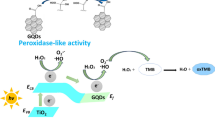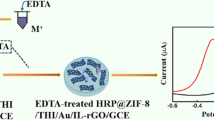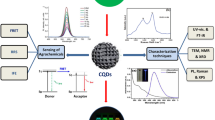Abstract
The authors describe the synthesis of a nanocomposite consisting of graphene oxide, cobalt(III) oxide and horseradish peroxidase (HRP/GO-Co3O4) in a nafion matrix. The composite, when deposited on a glassy carbon electrode (GCE), is shown to enable electrochemical sensing of H2O2. The morphology of the nanocomposite was characterized by field emission scanning electron microscopy, X-ray diffraction spectroscopy, energy dispersive X-ray spectroscopy, UV-vis spectroscopy, and FTIR spectroscopy. The response of the modified electrode to H2O2 was examined by cyclic voltammetry and DC potential amperometry at a working potential −0.57 V (vs. Ag/AgCl) at pH 7.0. Features include (a) a sensitivity of −18.7 ± 0.5 μA mM−1 cm−2, (b) a linear dynamic range from 1 mM to 30 mM, (c) a 2 mM detection limit, and (d) a response time of ~20 s. The performance of the sensor for the routine analysis was investigated by the determination of H2O2 present in hair dye product with appreciable percent recovery value. Moreover, the HRP/GO-Co3O4-nafion/GCE biosensor exhibited good selectivity towards H2O2 quantification in presence of common interfering species such as glucose, uric acid and ascorbic acid. This good analytical performance makes this biosensor a promising tool for sensing of H2O2.

A nanocomposite consisting of graphene oxide, cobalt(III) oxide and horseradish peroxidase was applied in an electrochemical sensor of H2O2. The sensor showed high sensitivity, −18.7 ± 0.5 μA mM−1 cm−2, a 2 mM detection limit, and a response time of ~20 s.







Similar content being viewed by others
References
Chen S, Yuan R, Chai Y, Hu F (2013) Electrochemical sensing of hydrogen peroxide using metal nanoparticles: a review. Microchim Acta 180:15
Li Y, Zhang JJ, Xuan J, Jiang LP, Zhu JJ (2010) Fabrication of a novel nonenzymatic hydrogen peroxide sensor based on Se/Pt nanocomposites. Electrochem Commun 12:777
Shi X, Gu W, Li B, Chen N, Zhao K, Xian Y (2014) Enzymatic biosensors based on the use of metal oxide nanoparticles. Microchim Acta 181:1
Shi L, Niu X, Liu T, Zhao H, Lan M (2015) Electrocatalytic sensing of hydrogen peroxide using a screen printed carbon electrode modified with nitrogen-doped graphene nanoribbons. Microchim Acta 182:2485
Zöpfl A, Sisakthi M, Eroms J, Matysik FM, Strunk C, Hirsch T (2016) Signal enhancement in amperometric peroxide detection by using graphene materials with low number of defects. Microchim Acta 183:83
Li SJ, JM D, Zhang JP, Zhang MJ, Chen J (2014) A glassy carbon electrode modified with a film composed of cobalt oxide nanoparticles and graphene for electrochemical sensing of H2O2. Microchim Acta 181:631
Luo Y, Liu H, Rui Q, Tian Y (2009) Detection of Extracellular H2O2 Released from Human Liver Cancer Cells Based on TiO2Nanoneedles with Enhanced Electron Transfer of Cytochrome c. Anal chem 81:3035
Xu F, Deng M, Li G, Chen S, Wang L (2013) Electrochemical behavior of cuprous oxide–reduced graphene oxide nanocomposites and their application in nonenzymatic hydrogen peroxide sensing. Electrochim Acta 88:59
Liu S, Chen A (2005) Coadsorption of horseradish peroxidase with Thionine on TiO2 nanotubes for biosensing. Langmuir 21:8409
Shi YT, Yuan R, Chai YQ, He XL (2007) Development of an amperometric immunosensor based on TiO2 nanoparticles and gold nanoparticles. Electrochim Acta 52:3518
Tatsuma T, Watanabe T (1991) Peroxidase model electrodes: heme peptide modified electrodes as reagentless sensors for hydrogen peroxide. Anal Chem 63:1580
Zong S, Cao Y, Zhou Y, Ju H (2006) Zirconia nanoparticles enhanced grafted collagen Tri-helix scaffold for unmediated biosensing of hydrogen peroxide. Langmuir 22:8915
Zhao Z, Lei W, Zhang X, Wang B, Jiang H (2010) ZnO-based amperometric enzyme biosensors. Sensors 10:1216
Bai HP, XX L, Yang GM, Yang YH (2008) Hydrogen peroxide biosensor based on electrodeposition of zinc oxide nanoflowers onto carbon nanotubes film electrode. Chinese. Chem Lett 19:314
Palanisamy S, Chen SM, Sarawathi R (2012) A novel nonenzymatic hydrogen peroxide sensor based on reduced graphene oxide/ZnO composite modified electrode. Sensor Actuat B: Chem 166–167:372
Ansari AA, Solanki PR, Malhotra BD (2009) Hydrogen peroxide sensor based on horseradish peroxidase immobilized nanostructured cerium oxide film. J Biotech 142:179
Ensafi AA, Jafari–Asl M, Rezaei B (2013) A novel enzyme-free amperometric sensor for hydrogen peroxide based on Nafion/exfoliated graphene oxide–Co3O4 nanocomposite. Talanta 103:322
Qi X, Gao H, Zhang Y, Wang X, Chen Y, Sun W (2012) Electrochemical DNA biosensor with chitosan-Co3O4 nanorod-graphene composite for the sensitive detection of Staphylococcus aureus nuc gene sequence. Bioelectrochem 88:42
Hosono E, Fujihara S, Honma I, Zhou H (2005) Fabrication of morphology and crystal structure controlled nanorod and nanosheet cobalt hydroxide based on the difference of oxygen-solubility between water and methanol, and conversion into Co3O4. J Mater Chem 15:1938
Dan Y, Lu H, Liu X, Lin H, Zhao J (2011) Ti/PbO2+ nano-Co3O4 composite electrode material for electrocatalysis of O2 evolution in alkaline solution. Int J Hydrogen Energ 36:1949
Ding Y, Wang Y, Su L, Bellagamba M, Zhang H, Lei Y (2010) Electrospun Co < sub > 3</sub > O < sub > 4</sub > nanofibers for sensitive and selective glucose detection. Biosens Bioelectron 26:542
Lu X, Zou G, Li J (2007) Hemoglobin entrapped within a layered spongy Co3O4 based nanocomposite featuring direct electron transfer and peroxidase activity. J Mater Chem 17:1427
Basu S, Bhattacharyya P (2012) Recent developments on graphene and graphene oxide based solid state gas sensors. Sens Actuat B: Chem 173:1
Sharma D, Kanchi S, Sabela MI, Bisetty K (2015) Insight into the biosensing of graphene oxide: present and future prospects. Arab J Chem 9:238
Roy S, Soin N, Bajpai R, Misra DS, McLaughlin JA, Roy SS (2011) Graphene oxide for electrochemical sensing applications. J Mater Chem 21:14725
Khan SB, Karimov KS, Chani MTS, Asiri AM, Akhtar K, Fatima N (2015) Impedimetric sensing of humidity and temperature using CeO2–Co3O4 nanoparticles in polymer hosts. Microchim Acta 182:2019
Khan SB, Khan SA, Asiri AM (2016) A fascinating combination of Co, Ni and Al nanomaterial for oxygen evolution reaction. Appl Surf Sci 370:445
Asif SAB, Khan SB, Khan SA, Asiri AM (2014) Efficient solar photocatalyst based on cobalt oxide/iron oxide composite nanofibers for the detoxification of organic pollutants. Nanoscale Res Lett 9:510
Niu X, Yang W, Ren J, Guo H, Long S, Chen J, Gao J (2012) Electrochemical behaviors and simultaneous determination of guanine and adenine based on graphene–ionic liquid–chitosan composite film modified glassy carbon electrode. Electrochim Acta 80:346
Khan MM, Ansari SA, Lee J, Cho MH (2013) Novel Ag@ TiO < sub > 2</sub > nanocomposite synthesized by electrochemically active biofilm for nonenzymatic hydrogen peroxide sensor. Mater Sci Eng: C 33:4692
You JM, Kim D, Kim SK, Kim MS, Han HS, Jeon S (2013) Novel determination of hydrogen peroxide by electrochemically reduced graphene oxide grafted with aminothiophenol–Pd nanoparticles. Sensor Actuat B: Chem 178:450
Zhang Y, Sun X, Jia N (2011) Direct electrochemistry and electrocatalysis of hemoglobin immobilized into poly (lactic-co-glycolic acid)/room temperature ionic liquid composite film. Sensor Actuat B: Chem 157:527
Zhiguo G, Shuping Y, Zaiju L, Xiulan S, Guangli W, Yinjun F, Junkang L (2011) An ultrasensitive hydrogen peroxide biosensor based on electrocatalytic synergy of graphene–gold nanocomposite, CdTe–CdS core–shell quantum dots and gold nanoparticles. Anal Chim Acta 701:75
Xie L, Xu Y, Cao X (2013) Hydrogen peroxide biosensor based on hemoglobin immobilized at graphene, flower-like zinc oxide, and gold nanoparticles nanocomposite modified glassy carbon electrode. Colloid Surface B 107:245
Jha SK, Kumar CN, Raj RP, Jha NS, Mohan S (2014) Synthesis of 3D porous CeO2/reduced graphene oxide xerogel composite and low level detection of H2O2. Electrochim Acta 120:308
Acknowledgments
The authors are grateful to the Center of Excellence for Advanced Materials Research (CEAMR) and Chemistry Department, King Abdulaziz University for providing research facilities. Authors would also like to acknowledge the support of the Ministry of Higher Education, Kingdom of Saudi Arabia for this research through a grant (PCSED-014-12) under the Promising Centre for Sensors and Electronic Devices (PCSED) at Najran University, Kingdom of Saudi Arabia.
Author information
Authors and Affiliations
Corresponding author
Ethics declarations
The author(s) declare that they have no competing interests.
Electronic supplementary material
ESM 1
(DOCX 292 kb)
Rights and permissions
About this article
Cite this article
Asif, S.A.B., Khan, S.B. & Asiri, A.M. Electrochemical sensor for H2O2 using a glassy carbon electrode modified with a nanocomposite consisting of graphene oxide, cobalt(III) oxide, horseradish peroxidase and nafion. Microchim Acta 183, 3043–3052 (2016). https://doi.org/10.1007/s00604-016-1942-0
Received:
Accepted:
Published:
Issue Date:
DOI: https://doi.org/10.1007/s00604-016-1942-0




